Related Research Articles
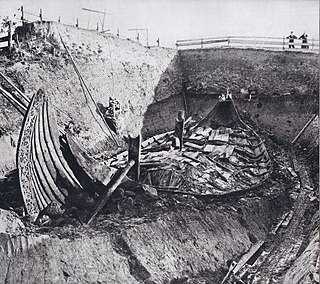
A ship burial or boat grave is a burial in which a ship or boat is used either as the tomb for the dead and the grave goods, or as a part of the grave goods itself. If the ship is very small, it is called a boat grave. This style of burial was practiced by various seafaring cultures in Asia and Europe. Notable ship burial practices include those by the Germanic peoples, particularly by Viking Age Norsemen, as well as the pre-colonial ship burials described in the Boxer Codex in the Philippines.
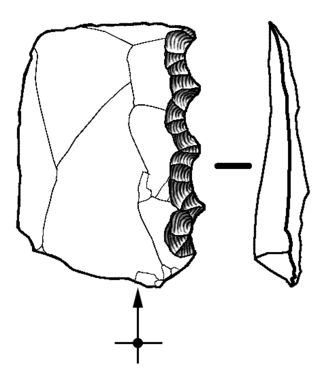
In archaeology, a denticulate tool is a stone tool containing one or more edges that are worked into multiple notched shapes, much like the toothed edge of a saw. Such tools have been used as saws for woodworking, processing meat and hides, craft activities and for agricultural purposes. Denticulate tools were used by many different groups worldwide and have been found at a number of notable archaeological sites. They can be made from a number of different lithic materials, but a large number of denticulate tools are made from flint.

Tabon Man refers to remains discovered in the Tabon Caves in Lipuun Point in Quezon, Palawan in the Philippines. They were discovered by Robert B. Fox, an American anthropologist of the National Museum of the Philippines, on May 28, 1962. These remains, the fossilized fragments of a skull of a female and the jawbones of three individuals dating back to 16,500 years ago, were the earliest known human remains in the Philippines, until a metatarsal from the Callao Man discovered in 2007 was dated in 2010 by uranium-series dating as being 67,000 years old. However, some scientists think additional evidence is necessary to confirm those fossils as a new species, rather than a locally adapted population of other Homo populations, such as H. erectus or Denisovan.
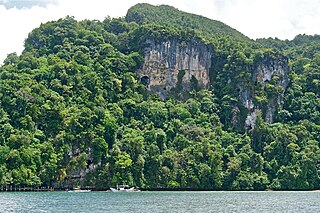
The Tabon Caves is a cave system located in Lipuun Point, Panitian, Quezon, Palawan in the Philippines. Dubbed as the country's "cradle of civilization", it is a site of archaeological importance due to the number of jar burials and prehistoric human remains found starting from the 1960s, most notably the Tabon Man. The system is a part of the Lipuun Point Reservation, which has been protected by the Philippine government as a museum reservation to protect the caves and its immediate vicinity from deforestation and to preserve the cultural artifacts present there.
Devil's Lair is a single-chamber cave with a floor area of around 200 m2 (2,200 sq ft) that formed in a Quaternary dune limestone of the Leeuwin–Naturaliste Ridge, 5 km (3.1 mi) from the modern coastline of Western Australia. The stratigraphic sequence in the cave floor deposit consists of 660 cm (260 in) of sandy sediments, with more than 100 distinct layers, intercalated with flowstone and other indurated deposits. Excavations have been made in several areas of the cave floor. Since 1973, excavations have been concentrated in the middle of the cave, where 10 trenches have been dug. Archaeological evidence for intermittent human occupation extends down about 350 cm (140 in) to layer 30, with hearths, bone, and stone artefacts found throughout. The site provides evidence of human habitation of Southwest Australia 50,000 years before the present day.

The Manunggul Jar is a secondary burial jar excavated from a Neolithic burial site in the Manunggul cave of the Tabon Caves at Lipuun Point in Palawan, Philippines. It dates from 890–710 B.C. and the two prominent figures at the top handle of its cover represent the journey of the soul to the afterlife.
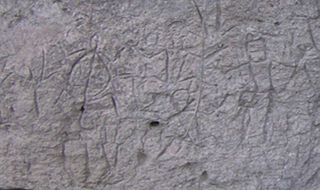
The prehistory of the Philippines covers the events prior to the written history of what is now the Philippines. The current demarcation between this period and the early history of the Philippines is April 21, 900, which is the equivalent on the Proleptic Gregorian calendar for the date indicated on the Laguna Copperplate Inscription—the earliest known surviving written record to come from the Philippines. This period saw the immense change that took hold of the archipelago from Stone Age cultures in 50000 BC to the emergence of developed thalassocratic civilizations in the fourth century, continuing on with the gradual widening of trade until 900 and the first surviving written records.
Samrong Sen on the east bank of the Stueng Chinit River is a prehistoric archaeological site in the Kampong Chhnang Province, Cambodia. Consisting of a very large fluviatile shell midden, it flourished in particular from 1500 BC to 500 BC.
Dewil Valley, located in the northernmost part of Palawan, an island province of the Philippines that is located in the Mimaropa region, is an archaeological site composed of thousands of artifacts and features. According to the University of the Philippines Archaeological Studies Program, or UP-ASP, the closest settlement can be found in New Ibajay, which is covered by the town capital of El Nido, which is located around 9 km (5.6 mi) south-east of Dewil Valley. Physically it measures around 7 km (4.3 mi) long, and 4 km (2.5 mi) wide. It is in this place which the Ille Cave, one of the main archaeological sites, can be found. It is actually a network of 3 cave mouths located at its base. It has been discovered that this site in particular has been used and occupied by humans over multiple time periods.
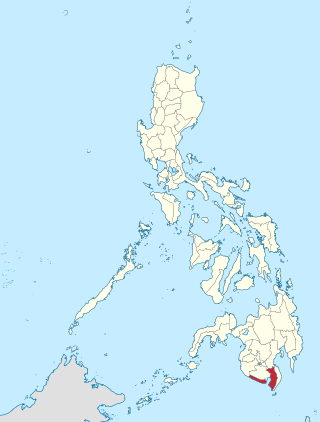
Sarangani is a province located in the Mindanao region of the Philippines and has a total land area of 4,441.79 square kilometers.. Historically, Sarangani already had an established community even before the Westerners came. The early Sarangani society was greatly affected by the Indian and Muslim cultures, and the first inhabitants were the indigenous natives called
Grave goods are utilitarian and ornamental objects buried with the deceased. "Pabaon", as present day Filipinos know, is the tradition of including the priced possessions or items of the dead to its grave because of the belief that these things might be helpful to the deceased as it travels to the life after death. This has been a practice since the neolithic times.
The Philippines is an archipelago located in Southeast Asia and consists of 7,641 islands. Prehistoric beads are among the most significant resources deriving from the human past. They are artifacts that inform individuals about archaeological records. Beads play a vital role in Asian lives, since they were utilized as human markers to indicate a territory; moreover, prehistoric beads were significant for ancestors as well as the people who occupied the identical territory. For instance, if beads are perished or destroyed, they can be recovered archaeologically due to their durability, which allows for the preservation of these resources. Furthermore, several of the decorative pieces and tools that they possess, as well as their culture, seem to reflect this maritime characteristic. Due to the fact that beads are transportable, compact in size, and appealing to the eye, they can essentially be discovered all over the world. Tools such as choppers made of shells as well as decorative pieces like shell beads are common in Southeast Asian archaeological records due to this characteristic. Various sites have been found to contain shell beads, including Sucgang Barrio in Bohol; Sibale Island, near Surigao; Suluan island, south of Samar; Lagen Island in Palawan; and Camotes Islands.
Minori Cave is part of the Callao limestone formation, located in Barangay Quibal, Municipality of Peñablanca, Cagayan Province in Northern Luzon. The said cave has two openings. One, designated as Mouth B, is located at 17° 43' 17" N latitude and 121° 49' 42" E longitude. The other opening, Mouth A is located 17° 43' 21" N latitude and 121° 49' 44" E longitude. The cave has an average elevation of about 200 m (656.2 ft) above sea level, and length and width of 147 m (482.3 ft) and 7 to 11 m, respectively. The cave is divided into four chambers with mouth A as chamber A and mouth B as chamber D. Chambers B and C are in between the two mouths.

The archaeology of the Philippines is the study of past societies in the territory of the modern Republic of the Philippines, an island country in Southeast Asia, through material culture.
Philippine ceramics are mostly earthenware, pottery that has not been fired to the point of vitrification. Other types of pottery like tradeware and stoneware have been fired at high enough temperatures to vitrify. Earthenware ceramics in the Philippines are mainly differentiated from tradeware and stoneware by the materials used during the process and the temperature at which they are fired. Additionally, earthenware and stoneware pottery can generally be referred to as ceramics that are made with local materials, while tradeware ceramics can generally be referred to as ceramics that are made with non-local materials.
R12 is a middle Neolithic cemetery located in the Northern Dongola Reach on the banks of the Seleim Nile palaeochannel of modern-day Sudan. The site is dated to between 5000 and 4000 BC. Centro Veneto di Studi Classici e Orientali excavated the site, within the concession of the Sudan Archaeological Research Society and after an agreement with it, between 2000 and 2003 over three digging seasons. The first was in 2000 and 33 graves were discovered. The second was in 2001 and another 33 graves were discovered. The third was in 2003 and the last 100 graves were discovered. There are 166 graves total at the site. Contents of the graves include ceramics, animal bones, grinding stones, human skeletons, and plant remains.
Symbolism is an abstract meaning given to an object or representative of one. Symbols can define certain aspects of cultures making them initially exclusive to particular groups. When it comes to symbolism in archaeology, artifacts found may display iconography with these abstract symbols or tell us more about the people who made them through their construction. Symbolism is not limited to only inanimate objects but can be found in the actions or being of living things as well. The Philippines, comprising more than 7,000 islands, is an archipelago where symbols of the past and present contribute to its unique culture. These symbols are influenced by and noticeable in burial practices, rituals, social status, architecture, agriculture, and The Philippines' place in the Austronesian world.
Ghaba is a Neolithic cemetery mound and African archaeological site located in Central Sudan in the Shendi region of the Nile Valley. The site, discovered in 1977 by the Section Française de la Direction des Antiquités du Soudan (SFDAS) while they were investigating nearby Kadada, dates to 4750–4350 and 4000–3650 cal BC. Archaeology of the site originally heavily emphasized pottery, as there were many intact or mostly intact vessels. Recent analysis has focused on study of plant material found, which indicates that Ghaba may have been domesticating cereals earlier than previously believed. Though the site is a cemetery, little analysis has taken place on the skeletons due to circumstances of the excavation and poor preservation due to the environment. The artifacts at Ghaba suggest the people who used the cemetery were part of a regionalization separating central Sudan's Neolithic from Nubia. While many traditions match with Nubia, the people represented at Ghaba had some of their own particular practices in food production and bead and pottery production, which likely occurred on a relatively small scale. They also had some distinct funerary traditions, as evidenced by their grave goods. The people at Ghaba would have likely existed at least partially in a trade network that spread through the Nile and to the Red Sea. They used agriculture, cultivation, and cattle for sustenance.

The Kaizuka Period ; literally the "Shellmound Period" is one of the periods of the prehistory of the Okinawa and Amami Islands. It is defined as the period of the prehistory in the Amami and Okinawa Islands with pottery. It lasts from 8000 BCE to the 11th or 12th centuries CE. The culture that develops during this period is called the Kaizuka Culture. It is divided into Early and Late Kaizuka Period, the difference residing in a shift in the settlement location and the development of trade with the neighbouring cultures, first Japan, and then China and Korea.
References
- ↑ Palmer, Arthur Beau. "Pacific Shell Adze". arthurbeaupalmer.com. Retrieved 5 September 2015.
- 1 2 3 "Shell Bracelets and Pendants - New Stone Age". nationalmuseum.gov.ph. National Museum of the Philippines. Retrieved 5 September 2015.
- ↑ Solheim, WG (2006). Archaeology And Culture In Southeast Asia: Unraveling The Nusantao
- 1 2 "Duyong Shell Adze". masterpieces.asemus.museum. Virtual Collection of Asian Masterpieces. Retrieved 5 September 2015.
- ↑ "National Cultural Treasures of Philippine Archaeology". nationalmuseum.gov.ph. National Museum of the Philippines. Retrieved 5 September 2015.